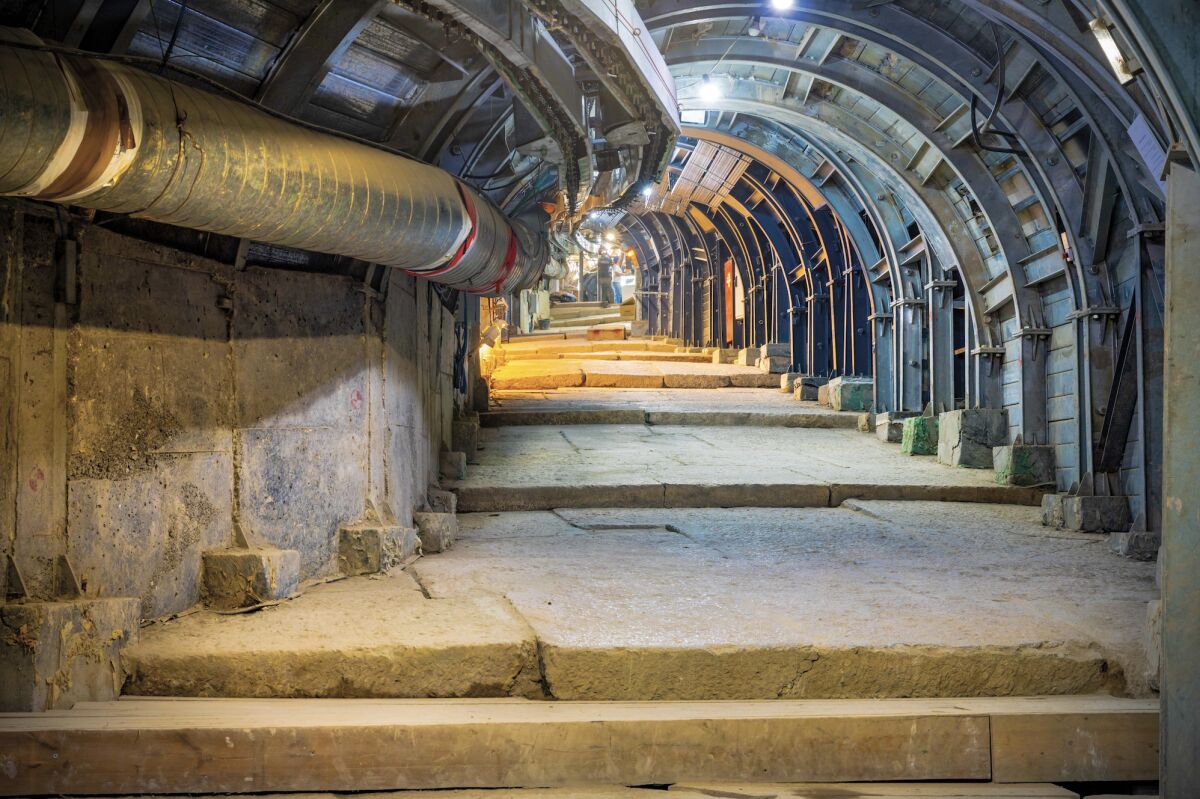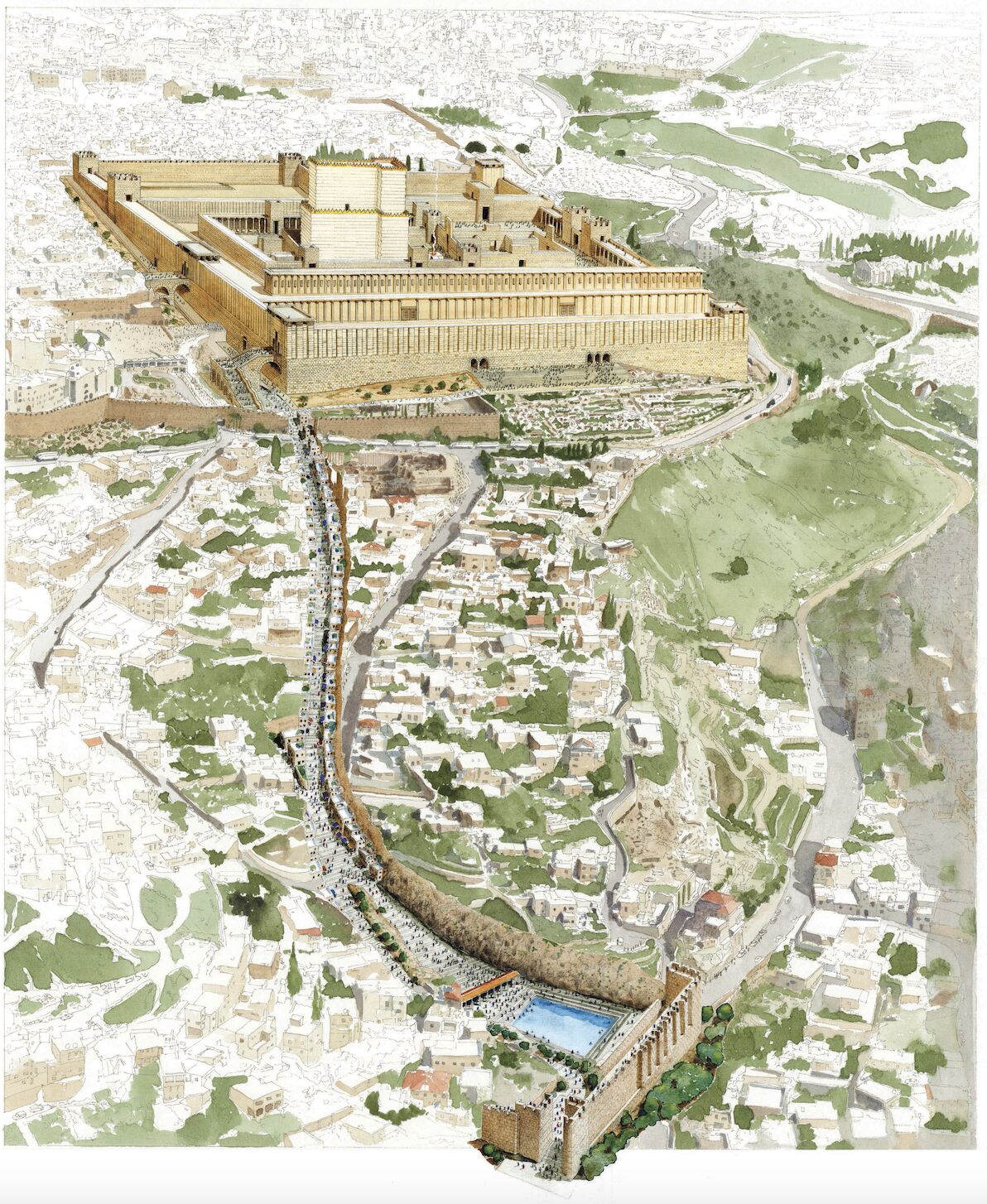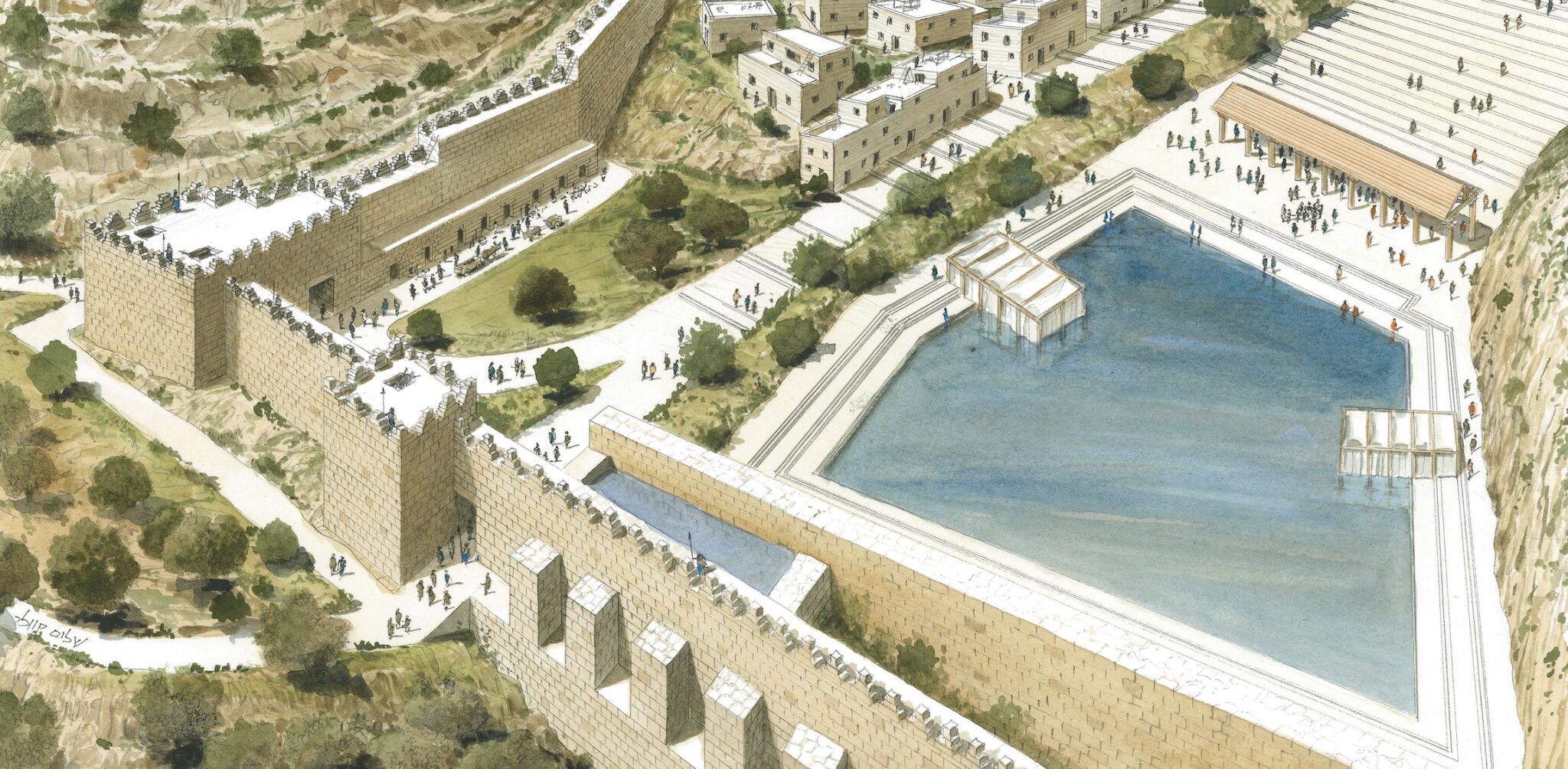Earlier this year, the City of David Foundation together with the Israel Antiquities Authority began excavating the famed biblical Pool of Siloam in ancient Jerusalem. In February, Let the Stones Speak assistant managing editor Brent Nagtegaal interviewed Ze’ev Orenstein, the City of David’s director of international affairs, to discuss this exciting new excavation. The following interview has been edited for clarity and length.
Brent Nagtegaal (BN): Thanks for visiting us here at the Armstrong Institute. Let’s begin with you telling us about the City of David and about your organization, the City of David Foundation.
Ze’ev Orenstein (ZO): You’re welcome. Up until about 150 years ago, when people wondered where the original biblical city of Jerusalem [the Jerusalem synonymous with figures such as David, Solomon and Hezekiah] was located, everyone imagined it to be inside the Old City of Jerusalem, surrounded by the iconic Old City walls. These walls are about 500 years old. But ancient Jerusalem is about 4,000 years old; King David lived 3,000 years ago. Still, until relatively recently, everyone thought that the Old City was biblical Jerusalem.
In 1867, Queen Victoria of England sent a man by the name of Capt. Charles Warren to the Holy Land to uncover the treasures of the Bible. Naturally, Warren wanted to search the Temple Mount, or biblical Mount Moriah. The Ottoman Turks were in charge of this area at the time, and they denied Warren the opportunity to excavate the Temple Mount. To this day, due to religious and political sensitivities, there has been virtually no archaeological activity on the Temple Mount. Charles Warren had a problem. So he said, “If I can’t dig on the Temple Mount, I’ll dig near it.”
So Warren comes south down the hill and discovers the Gihon Spring, the life source of ancient Jerusalem going back thousands of years. One discovery leads to another, and Warren soon comes up with the theory that the original biblical city of Jerusalem, the city of David, the place where Jerusalem began, was not located inside the walls of the Old City, but was located just outside.
At that time, scholars and laymen alike rejected the idea. They ridiculed Charles: “Do you really believe this barren 11-acre ridge is the site of ancient Jerusalem, with significance, not to millions, but to billions of people around the world?” He said, “I’m telling you, this is the spot.”
Over the next 150 years, the City of David became one of the most archaeologically excavated sites in the world and the most excavated site in Israel. Today, everyone recognizes that the City of David is not inside the Old City. The place where the kings of the Bible ruled, where the prophets of the Bible preached, is not in the Old City—it’s in the City of David, just outside the walls of the Old City of Jerusalem.
Over the last three decades, the City of David Foundation has been bringing the archaeology back, bringing the tourism back—bringing the City of David, the place where Jerusalem began—back to life. Our goal is to transform this once forgotten and barren 11-acre ridge into one of the most significant heritage sites on the planet.
BN: What achievements have you made in recent years? What can tourists visiting the site expect to see?
ZO: The historian Josephus recorded that going back about 2,000 years to the time of Jesus, there would have been millions of people making pilgrimage to Jerusalem. We are talking about the feasts of Passover, Pentecost and Tabernacles. How did all of those people make their way up to the temple?

Over the past couple of years, archaeologists have uncovered and are excavating as we speak what I call the biblical superhighway, or the Pilgrimage Road. This is the very road that would have taken our ancestors, whether you are Jewish or Christian, on pilgrimage up to the temple. This road would have taken you on a half-mile journey up the hill to the temple.
Fifteen chapters of the Psalms (from 120 to 134) begin with the same words: “A song of ascents.” The way most people understand this is that it is referring to a spiritual ascent: going to Jerusalem and to the temple, it’s holy, etc.
Thousands of years ago, when they were making a pilgrimage, the vast majority of people would have gone up to the temple from the southern part of the City of David. As they made that journey [or ascent], they sang those 15 chapters. The songs of ascent are not just about a spiritual ascent, but they are actually a description of the physical pilgrimage experience. When you’re in the place where the Bible happened, the words of the Bible come to life. There is no other place in the world where you can actually experience those songs of a physical ascent going up to the temple in Jerusalem, other than walking along the Pilgrimage Road in the City of David.
In a few years, people of all faiths and backgrounds will be able to walk in the footsteps of the Bible, re-creating that pilgrimage experience. Visitors will be able to walk through the City of David to the Western Wall and the southern steps of the Temple Mount. They will literally walk on the very same flagstones our ancestors did thousands of years ago.

BN: This is an amazing discovery! This pilgrimage journey will begin at the Pool of Siloam. Can you describe its initial discovery and what the City of David Foundation is doing today at the Pool of Siloam?
ZO: We have a teaching in our faith that says “God has many messengers.” Back in 2004, a sewage pipe burst beneath the road at the southern end of the City of David. The municipality of Jerusalem sent in a construction crew to repair the sewer pipe. But Jerusalem is not your average municipality; the City of David is not just another part of Jerusalem. Here, when a sewage pipe bursts, you not only send in construction crews, you also send in archaeologists. One day, as the construction crew was working, the archaeologist Eli Shukron heard scraping. He explored it with archaeologist Ronny Reich. They learned that as they were preparing to repair the sewage pipe, the workers had inadvertently uncovered a series of ancient stone steps dating back some 2,000 years [the time of Jesus].
When they studied the steps, the archaeologists observed that they were similar to another set of steps in Jerusalem: the southern steps to the Temple Mount, the primary entryway up into Herod’s temple! They figured that there must be a connection between the two sets of stairs. They realized they had discovered the ancient Pool of Siloam, one of the most significant biblical heritage sites in all of Jerusalem.
The Pool of Siloam has deep significance for Christians and Jews alike. In the Christian scriptures, the story of the healing of the man born blind took place at the Pool of Siloam. The Bible also mandates that before a person could enter the temple, he first had to cleanse himself by going to a ritual bath, known as a mikveh. The Pool of Siloam was as large as two Olympic-sized swimming pools. Why so big? Josephus said that 2,000 years ago, almost 3 million people participated in the pilgrimage to the temple. That is a lot of people who had to cleanse.
The Pool of Siloam, at the southern end of the City of David, is the largest ritual bath in all of Jerusalem, by far!
BN: And this discovery occurred in 2004?
ZO: Yes; back then we excavated about 3 to 5 percent of the entire pool. Essentially, we exposed a nice set of steps in the northeast corner of the pool. We could see that the steps also extended toward the south. But there was a property line there that we were not able to cross. Unfortunately, the owners of the property at the time, for whatever reason, were not interested in unearthing the rest of the Pool of Siloam.
Recently, the ownership of the property changed. Now, for the first time in over 2,000 years, we are able to excavate the entire Pool of Siloam. Again, this is the size of two Olympic-sized swimming pools—an acre and a half! Excavation has already begun, and we are currently clearing away the upper layers of modern earth.
BN: Right, I noticed some heavy machinery working at the site. I assume you’re using that to remove the modern material, right?
ZO: Yes. Let’s put it this way: If you’re moving fill that has Coke cans in it, you have nothing to worry about. No one has lived on this site for many decades, and debris has built up over time. Once all this modern debris is cleared away, then we dig down and start the archaeology.
Archaeologists with the Israel Antiquities Authority [iaa] have already dug pilot trenches to get a sense of what will be uncovered. It is pretty exciting. This is one of the most significant heritage sites in all of Jerusalem; we expect to excavate material from not just the Second Temple Period, but even the First Temple Period. This leads to what will be an interesting archaeological question. The archaeologists are going to dig down and presumably find remnants of the pool dating back 2,000 years. However, as Bible scholars know, this is not the original Pool of Siloam.
2 Kings 20:20 tells us that the original Pool of Siloam was engineered by King Hezekiah, who was a direct descendant of King David. This occurred [in the late eighth century b.c.e.] when he was trying to save Jerusalem from the impending Assyrian siege by Sennacherib, king of Assyria. Hezekiah took the waters from the Gihon Spring and diverted the waters of the spring to flow entirely within the City of David, exiting into the Pool of Siloam.
So the question is: Will the archaeologists also find remnants of the original pool built by Hezekiah, or only of the pool dating back to Herod?
BN: Today we have no evidence of the Pool of Siloam from the time of Hezekiah. I guess the archaeologists, as they dig and remove the upper layers of material, will do some probing to see what lies beneath?
ZO: Yes. There used to be an American game show called Let’s Make a Deal. So you play some game and let’s say you win a tv. Then the host gives you a choice: You can go home with your nice new tv, or you could look behind door number two. But to look behind door number two, you have to give up your tv. Now, behind door number two there might be a brand-new car, or there could be nothing. This is how archaeology sometimes works. Let’s say that the entire 2,000-year-old pool is intact—that it’s all there. What do you do? Do we stop excavating? Or do we perhaps excavate a portion of the pool to see if there is something deeper?
We could actually uncover, for the first time in history, the original Pool of Siloam dating back 2,700 years. Or we might remove a portion of the [Herodian] pool to find there is no remnant of the older pool. Perhaps when Herod made his pool, he cleared out everything that came before him. That is possible. Thankfully, this isn’t my decision to make. The iaa will have to cross this bridge when the time comes. But it is exciting to think about.
BN: Archaeologists face this question all the time. Often, the importance of the find above will determine whether you continue excavating through it. Most archaeologists would probably be inclined to go through it to see what lies beneath. If they don’t find anything, they could always restore the pool. Plus, you might have to dig under the pool to date it accurately.
BN: What is the time frame for the Pool of Siloam dig?
ZO: It will probably take five years or so to unearth the entirety of the pool. As this is being done, we are also excavating the length of the Pilgrimage Road. Imagine, five years from now, a visitor to Jerusalem will be able to visit the fully revealed Pool of Siloam and then walk the Pilgrimage Road north all the way to the Western Wall and southern steps of the Temple Mount. They will be literally walking in the footsteps of the Bible from 2,000-plus years ago. It will be incredible!
When people think of the great wonders of the world, people think of the pyramids in Egypt or the Colosseum in Rome. I believe that when we finish revealing the entirety of the Pool of Siloam and the Pilgrimage Road, they will together be one of the great wonders of the world. But really, they will be in a category of their own. I’ll tell you why: When a person goes to see the Colosseum or the pyramids, the person says, “Wow, look at the grandeur of the pharaohs!” or, “Look at the might of the Roman Empire!” But where are the pharaohs today? Where is the great Roman Empire today? The answer is the same: in museums, history books and with some monuments left behind.
But when a person visits Jerusalem and sees the Pool of Siloam, and walks along the Pilgrimage Road, they are not just witnessing a piece of history, but actually the continuation of a story. The people who walked that road and went to that pool thousands of years ago, it is their descendants—who worship the same God, have the same customs, traditions, festivals and in some cases, speak the same language. It is the same Jerusalem, the same Bible, the same faiths here. Where else in the world do you have that? Not as a “once upon a time” type of thing, but something both as timeless, timely and relevant as it ever was—to billions of people around the world! This is a big privilege: We are living at a time where we are able to bring Jerusalem, its heritage and its history back to life, not only in the sense where it’s in a museum and behind glass, but where people can actually engage with it, touch it, walk on it, and see it with their own eyes!
BN: I agree. This is such a special time for archaeology in Jerusalem, and across Israel. We appreciate everything the City of David Foundation has done and look forward to seeing what you uncover at the Pool of Siloam.
ZO: I would just say one more thing. A testament to the work that the Armstrong Institute is doing and what we are doing in the City of David is, how many archaeological excavations are there in the world that in the grand scheme of things matter to people today? Yes, history is important, and we want to know about our past. But how many ancient civilizations really still matter today or are really relevant today? The excavations taking place today—yes, in Israel, but in Jerusalem, in places like the City of David and in the Ophel area—in the biblical Jerusalem envelope matter to billions of people. And that history matters today and will matter tomorrow. To have a hand in that, to be a steward and to unearth this—not just for our benefit but for the benefit of billions of people around the world, and also for future generations—is a big privilege. And I know that it is something that the Armstrong Institute also takes very seriously: that this is not just another dig—it is Jerusalem.

